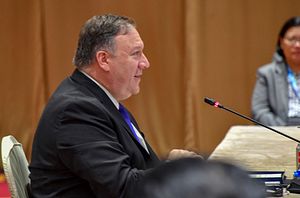The recent visit by U.S. Secretary of State Mike Pompeo to Malaysia, Singapore, and Indonesia signals a new era of competition between the United States and China in Southeast Asia. In particular, Pompeo laid out the Trump administration’s Indo-Pacific strategy and indirectly challenged China’s investment strategy in the region by calling for a more “open and transparent” investment strategy. The U.S. strategy seems to emphasize private-sector investment, which contrasts with China’s state-led Belt and Road Initiative, involving many states in the region with massive infrastructure projects. To add action to words, the United States announced that it would invest $113 million in sectors like technology, energy, and infrastructure in the Indo-Pacific, thus offering an alternative to China’s Belt and Road Initiative.
Given that the Trump administration has openly identified China as a strategic competitor and an economic threat, competition is bound to occur between the two. And Southeast Asia may be the most likely site of such a competition, due to the region’s geoeconomic and geostrategic importance. The key question is: Can the United States compete with China in Southeast Asia? There is actually no clear answer to this question, as both powers have their own advantages and disadvantages in the Asia-Pacific. Simply put, China has advantages in economics and geography whereas the United States has advantages in geopolitics and global leadership.
As U.S. scholar David Shambaugh recently pointed out in an article, the United States still is a global power with substantial advantages in Southeast Asia, though the balance of influence could change if Washington does not compete effectively in the region. The U.S. advantages in the region are clear.
First of all, the United States has multiple allies and partners in the region, including the Philippines, Singapore, Thailand, and so on. This is important because these states will look to the United States for security assistance if something bad happens eventually. Considering the fact that China does not have a formal ally in the region and is unlikely to find one in the near future, the U.S. alliance system is a big advantage for the United States.
Second, some of the regional states still hold varying degrees of suspicion toward China due to historical, economic, or strategic reasons. They may benefit from doing business with China, but they also want to keep a healthy distance from China, which might one day become the default hegemon in the Asia-Pacific.
Third, U.S. values are still prevalent in the region, though U.S. soft power has suffered to some degree since the onset of the Trump administration, whose “America First” approach has not won any friends in the Asia-Pacific. By and large, however, the Asia-Pacific still looks up to the United States in assessing a more effective mode of governance, even as the U.S. itself is facing major challenges domestically.
Interestingly, China’s advantages are exactly what United States lacks in the Asia-Pacific, i.e., economic closeness and geographic integration. This is even more true in the backdrop of the ongoing U.S.-China trade war, as many ASEAN members watch uneasily and fear the fallout of this ugly economic competition. More specifically, China holds three main advantages when it comes to China-ASEAN relations.
First and undoubtedly, China’s economic relations with ASEAN are strong and growing. In 2017, bilateral trade between China and ASEAN was at a record high, reaching $514 billion. And the trading relationship is a relatively healthy one as China’s trade surplus with ASEAN as a whole is only $43 billion. China is ASEAN’s largest trading partner whereas the United States is only the fourth largest one, giving China a major advantage in dealing with ASEAN. Moreover, over the last five years, China has been pushing forward with the Belt and Road Initiative across ASEAN member states, despite some setbacks with projects in Malaysia and elsewhere. The ongoing trade war between the United States and China has also provided new impetus to conclude the Regional Comprehensive Economic Partnership, a trade agreement that includes most Asian economies but not the United States. In this context, the U.S. commitment of $113 million dollars to the region is dwarfed by China’s mega projects across ASEAN.
Second, China takes ASEAN and the region much more seriously than the United States does. For geographic and strategic reasons, China must build a good and effective relationship with Southeast Asia if Beijing wants to increase its global weight. No other region is as close and as important strategically as ASEAN to China — not even the Northeast Asian region. The new slogan of Chinese foreign policy, to build a “community of shared future,” must start with Southeast Asia and this success, if achieved, will further prove the Chinese model’s global applicability.
Third, China has an advantage simply because it is close to the ASEAN region. In addition to the daily business interactions between China and ASEAN, the people-to-people exchanges between China and ASEAN are rapidly increasing as well. The number reached 50 million in 2018 and the number of student exchanges has also increased to 200,000, reflecting an increasingly strong pillar in China-ASEAN cooperation.
Of course, as we mentioned in the beginning, the era of competition between the United States and China has just begun, and the final outcome, if there is any, in Southeast Asia is still uncertain as both the U.S. and China must first address their serious domestic challenges. Moreover, Southeast Asia is not a battleground for superpowers to grab or compete in; it can play an active and effective role in changing regional dynamics and even the global balance of power. This is a point that will serve both the United States and China well if they want to build an enduring relationship with ASEAN member states.
Dingding Chen is a contributor to The Diplomat‘s Flashpoints channel and the founder of the Intellisia Institute. You Wang is an assistant research fellow at the Intellisia Institute.

































